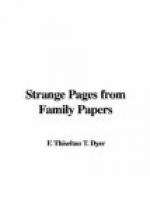This eccentric character was the subject of much speculation in his lifetime, and, curious to say, in the year 1771, it was proved to the satisfaction of a jury, on a trial before Lord Chief Justice Mansfield, that the Chevalier was of the female sex. The case in question arose from a wager between Hayes, a surgeon, and Jacques, an underwriter, the latter having bound himself, on receiving a premium, to pay the former a certain sum whenever the fact was established that D’Eon was a woman. One of the witnesses was Morande, an infamous Frenchman, who gave such testimony that no human being could doubt the fact of D’Eon being of the female sex, and two French medical men gave equally conclusive evidence. The result of this absurd trial was that the jury returned a verdict for the plaintiff, with L702 damages.[45] But all doubt was cleared away when D’Eon died, in the year 1810, for, an examination of the body being made, it was publicly declared that the Chevalier was an old man. Walpole collected some facts about this remarkable man, and writes: “The Due de Choiseul believed it was a woman. After the death of Louis XV., D’Eon had leave to go to France, on which the young Comte de Guerchy went to M. de Vergennes, Secretary of State, and gave him notice that the moment D’Eon landed at Calais he, Guerchy, would cut his throat, or D’Eon should his; on which Vergennes told the Count that D’Eon was certainly a woman. Louis XV. corresponded with D’Eon, and when the Duc de Choiseul had sent a vessel, which lay six months in the Thames, to trepan and bring off D’Eon, the king wrote a letter with his own hand to give him warning of the vessel.”
Like the Chevalier D’Eon, a certain individual named Russell, a native of Streatham, adopted the guise and habits of the opposite sex, and so skilfully did he keep up the deception that it was not known till after his death. It appears from Streatham Register that he was buried on April 14, 1772, the subjoined memorandum being affixed to the entry: “This person was always known under the guise or habit of a woman, and answered to the name of Elizabeth, as registered in this parish, November 21, 1669, but on death proved to be a man. It also appears from the registers of Streatham Parish, that his father, John Russell, had three daughters, and two sons—William, born in 1668, and Thomas in 1672; and there is very little doubt that the above person, who was also commonly known as Betsy the Doctress, was one of these sons.”
It is said that when he assumed the garb of the softer sex he also took the name of his sister Elizabeth, who, very likely, either died in infancy, or settled at a distance; but, under this name, he applied, about two years before his death, for a certificate of his baptism. Early in life, he associated with the gypsies, and became the companion of the famous Bampfylde Moore Carew. Later on in life he resided at Chipstead, in Kent, and there catered for the miscellaneous wants of the villagers. He also visited most parts of the continent as a stroller and a vagabond, and sometimes in the company of a man who passed for his husband, he moved about from one place to another, changing his “maiden” name to that of his companion, at whose death he passed as his widow, being generally known by the familiar name of Bet Page.




